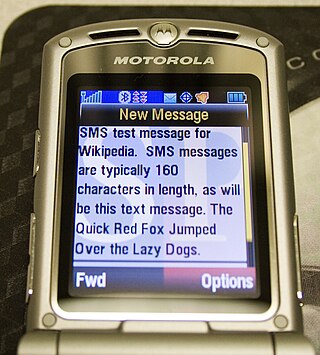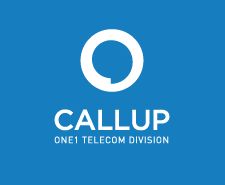
Short Message/Messaging Service, commonly abbreviated as SMS, is a text messaging service component of most telephone, Internet and mobile device systems. It uses standardized communication protocols that let mobile devices exchange short text messages. An intermediary service can facilitate a text-to-voice conversion to be sent to landlines.
The Intelligent Network (IN) is the standard network architecture specified in the ITU-T Q.1200 series recommendations. It is intended for fixed as well as mobile telecom networks. It allows operators to differentiate themselves by providing value-added services in addition to the standard telecom services such as PSTN, ISDN on fixed networks, and GSM services on mobile phones or other mobile devices.
Multimedia Messaging Service (MMS) is a standard way to send messages that include multimedia content to and from a mobile phone over a cellular network. Users and providers may refer to such a message as a PXT, a picture message, or a multimedia message. The MMS standard extends the core SMS capability, allowing the exchange of text messages greater than 160 characters in length. Unlike text-only SMS, MMS can deliver a variety of media, including up to forty seconds of video, one image, a slideshow of multiple images, or audio.

Text messaging, or texting, is the act of composing and sending electronic messages, typically consisting of alphabetic and numeric characters, between two or more users of mobile devices, desktops/laptops, or another type of compatible computer. Text messages may be sent over a cellular network or may also be sent via satellite or Internet connection.

A conference call is a telephone call in which someone talks to several people at the same time. The conference call may be designed to allow the called party to participate during the call or set up so that the called party merely listens into the call and cannot speak.
GSM services are a standard collection of applications and features available over the Global System for Mobile Communications (GSM) to mobile phone subscribers all over the world. The GSM standards are defined by the 3GPP collaboration and implemented in hardware and software by equipment manufacturers and mobile phone operators. The common standard makes it possible to use the same phones with different companies' services, or even roam into different countries. GSM is the world's most dominant mobile phone standard.
Mobile content is any type of web hypertext and information content and electronic media which is viewed or used on mobile phones, like text, sound, ringtones, graphics, flash, discount offers, mobile games, movies, and GPS navigation. As mobile phone use has grown since the mid-1990s, the usage and significance of the mobile devices in everyday technological life has grown accordingly. Owners of mobile phones can now use their devices to make photo snapshots for upload, twits, mobile calendar appointments, and mostly send and receive text messages, listen to music, watch videos, take mobile pictures and make videos, use websites to redeem coupons for purchases, view and edit office documents, get driving instructions on mobile maps and so on. The use of mobile content in various areas has grown accordingly.
Short codes, or short numbers, are short digit-sequences - significantly shorter than telephone numbers - that are used to address messages in the Multimedia Messaging System (MMS) and short message service (SMS) systems of mobile network operators. In addition to messaging, they may be used in abbreviated dialing.
Mobile marketing is a multi-channel online marketing technique focused at reaching a specific audience on their smartphones, feature phones, tablets, or any other related devices through websites, e-mail, SMS and MMS, social media, or mobile applications. Mobile marketing can provide customers with time and location sensitive, personalized information that promotes goods, services, appointment reminders and ideas. In a more theoretical manner, academic Andreas Kaplan defines mobile marketing as "any marketing activity conducted through a ubiquitous network to which consumers are constantly connected using a personal mobile device".
The telecommunications industry in China is dominated by three state-run businesses: China Telecom, China Unicom and China Mobile. The three companies were formed by restructuring launched in May 2008, directed by the Ministry of Information Industry (MII), National Development and Reform Commission (NDRC) and the Minister of Finance. Since then, all three companies gained nationwide fixed-line and cellular mobile telecom licenses in China. In 2019, all three telecoms were issued 5G national licenses.
An SMS gateway or MMS gateway allows a computer to send or receive text messages in the form of Short Message Service (SMS) or Multimedia Messaging Service (MMS) transmissions between local and/or international telecommunications networks. In most cases, SMS and MMS are eventually routed to a mobile phone through a wireless carrier. SMS gateways are commonly used as a method for person-to-person to device-to-person communications. Many SMS gateways support content and media conversions from email, push, voice, and other formats.
Aldiscon Limited was a telecommunications software company founded in Dublin, Ireland, in 1988. The company supplied software products to mobile phone operators and became a leader in the supply of short message service centres (SMSC).
Mobile advertising is a form of advertising via mobile (wireless) phones or other mobile devices. It is a subset of mobile marketing, mobile advertising can take place as text ads via SMS, or banner advertisements that appear embedded in a mobile web site.
Wireless Application Protocol (WAP) is a technical standard for accessing information over a mobile wireless network. A WAP browser is a web browser for mobile devices such as mobile phones that use the protocol. Introduced in 1999, WAP achieved some popularity in the early 2000s, but by the 2010s it had been largely superseded by more modern standards. Almost all modern handset internet browsers now fully support HTML, so they do not need to use WAP markup for web page compatibility, and therefore, most are no longer able to render and display pages written in WML, WAP's markup language.
Chikka, short for Chikka Text Messenger, was an Internet-based instant messaging application that supported free SMS or text messaging between online users and offline mobile subscribers. Chikka was released by Chikka Philippines, Inc. in the early 2000 and eventually established its connection with the country's network operators Smart Communications (2001), Globe Telecom (2002) and Sun Cellular (2004). With up to billions of messages being exchanged between online and mobile communities worldwide through Chikka, it is probably the world's first commercially successful integration of web and mobile utilities.
SMS Home Routing is a modification to the original GSM specifications that changed the way inbound (off-net) SMS messages are treated by mobile telecommunications networks. Adopted by the 3GPP in 2007, Home Routing was devised to enable mobile networks to offer a full range of advanced services on both inbound and outbound SMS, giving more utility to phone users and enabling operators to generate additional revenue.

Acision was a privately held British mobile communications network infrastructure company engaged in messaging and charging systems that enable popular services such as Short message service (SMS), Multimedia Messaging Service (MMS), mobile internet browsing, mobile broadband, and voicemail. In particular, Acision specialised in providing IP messaging to over-the-top media services and other enterprises.
An over-the-top (OTT) media service is a media service offered directly to viewers via the Internet. OTT bypasses cable, broadcast, and satellite television platforms—the mediums through which companies have traditionally acted as controllers or distributors of such content. It has also been used to describe no-carrier cellphones, for which all communications are charged as data, avoiding monopolistic competition, or apps for phones that transmit data in this manner, including both those that replace other call methods and those that update software.

Sinch, formerly CLX Communications, is a telecommunications and cloud communications platform as a service (PaaS) company. Headquartered in Stockholm, Sweden, Sinch also has offices in over 60 cities worldwide, including Atlanta, Chicago, London, Madrid, Singapore and Sydney.

CALLUP is a global telecommunications company. Headquartered in Israel, CALLUP is a subsidiary of publicly traded One1 Group TASE: ONE.




